4. Humanities in the Workplace
A final set of questions in the survey asked about engagement with the humanities in the workplace. Research about the relationship between humanities education and the workplace tends to examine employment patterns, earnings, and the needs of employers, but rarely explores the use of humanities skills on the job.23 The survey sought to address that imbalance.
Drawing on existing literature on the subject, and after consultation with stakeholders in the field, the survey inquired about a set of skills often cited as particular benefits of humanities study. These included reading, writing, use of a language other than English, working with and understanding others, and applying a historical perspective to a task.24 The survey asked about the frequency with which respondents used these skills in their jobs and whether they felt limited by a deficiency in any of these skill areas.
The survey revealed that a substantial share of Americans deployed humanities skills with some regularity in their current or most recent job. Of the seven skill areas included in the survey, Americans used an average of four at least sometimes in the workplace, and 81% used at least one of these skills often or very often in their jobs.
More than half of Americans worked with people from different cultures often or very often as part of their work, and a slightly larger share engaged in descriptive writing; however, Americans were far less likely to use other humanities-related skills (Figure 4A). The skill they were least likely to use in the workplace was speaking languages other than English (LOTE), with less than 10% of Americans doing so often or very often.
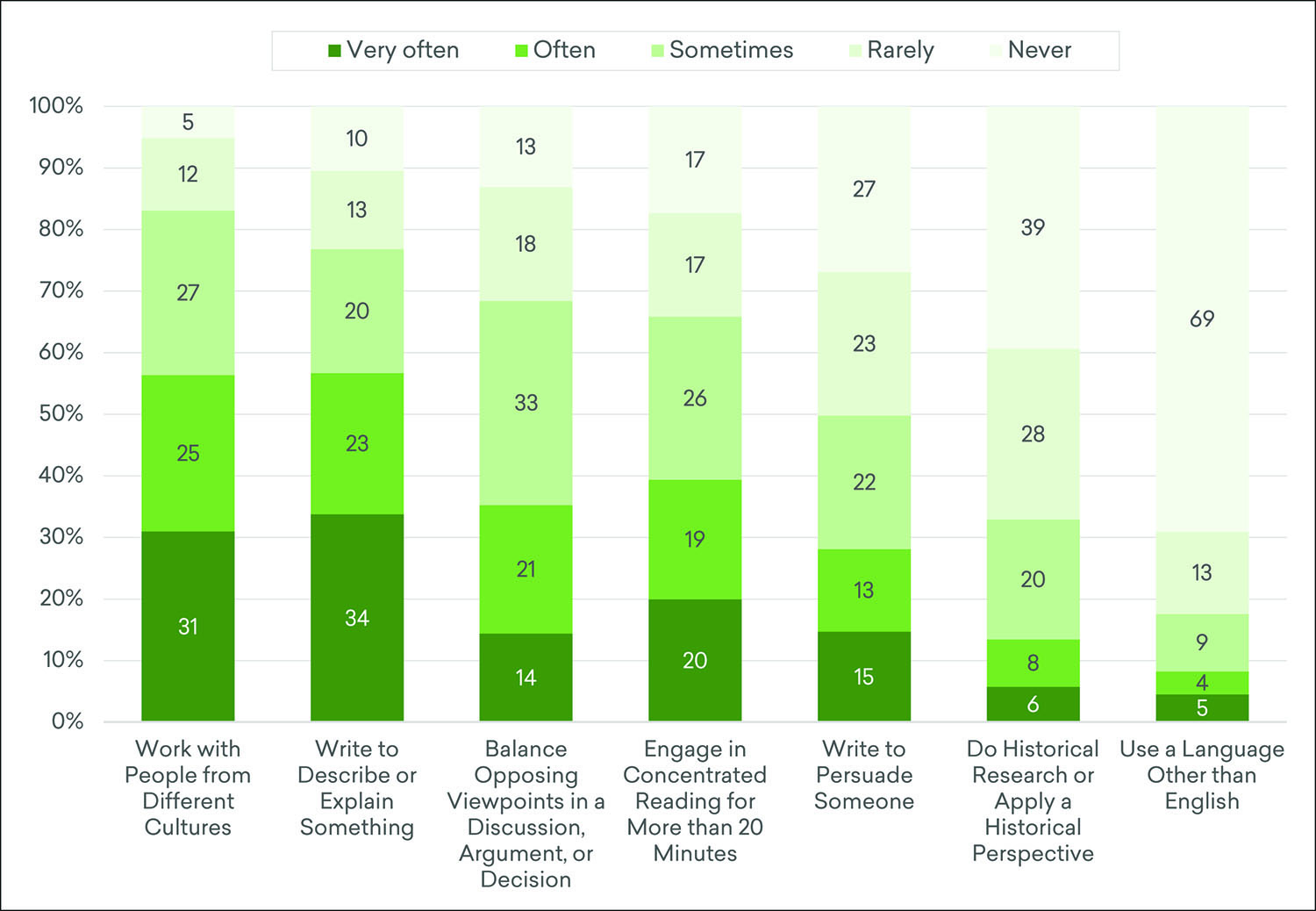
* Skills are listed in descending order by the size of the share who used the skill at least “sometimes.” The frequency shares for a given subject may sum to 99% or 101% due to rounding.
Source: Survey of the Humanities in American Life, 2019.
For each skill, a majority of Americans believed the competence was necessary for their job (Figure 4B).25 Nevertheless, a substantial share of Americans believed that they did not need these skills to do their work. Approximately a fifth of Americans indicated that they did not need to read technical materials related to the job or write descriptively, while nearly one-third of Americans’ jobs did not call for persuasive writing or understanding other cultures. Nearly half of Americans thought that historical research and LOTE were unnecessary on the job. Across all seven humanities competencies in the survey, however, only 9% of adults believed that none of these skills was necessary for their job.
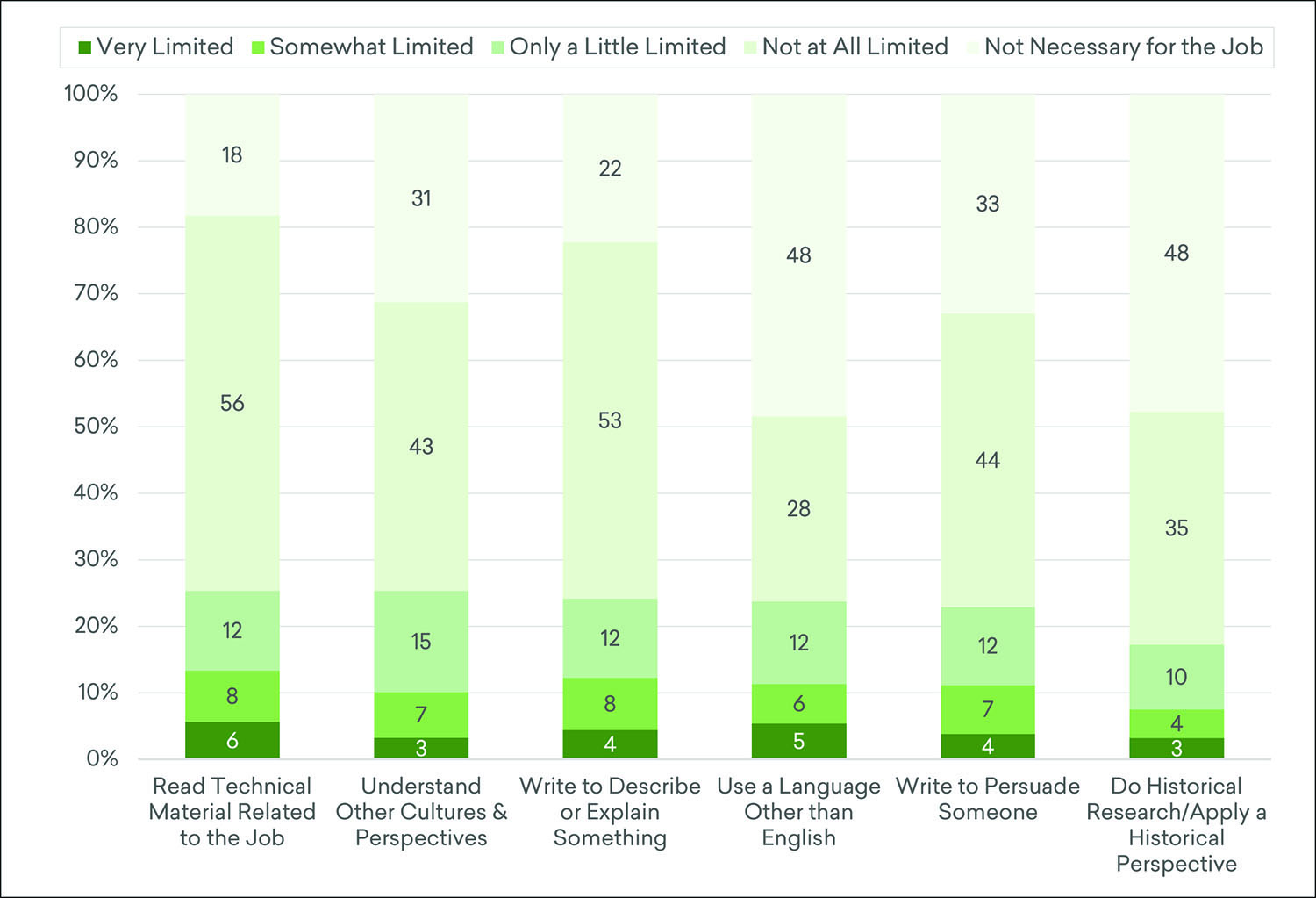
* Skills are listed in descending order by the size of the share who believed they were limited in any way at their job. The frequency shares for a given skill may sum to 99% or 101% due to rounding.
Source: Survey of the Humanities in American Life, 2019.
In most skill areas, roughly one in four Americans believed a deficiency had hampered them in their job. The exception was use of historical research or perspective on the job, which had the smallest share (17%). The share who believed a lack of these skills had done more than a little damage to them professionally (by limiting them somewhat or more in their job) was substantially smaller, but it still ranged from 14% of Americans who believed their career had been hampered by their ability to read technical materials to 7% who thought their lack of facility with historical research and perspective had impeded their work. Looking across all of these skill areas, 29% of Americans felt they had been held back in their jobs at least somewhat by a deficit in one or more area.
Who Uses the Humanities at Work?
Looking at the work use of humanities skills overall (employing a scale constructed in a manner similar to those for leisure-time engagement and perception in Chapters 1 and 2), several differences among demographic groups are apparent (Figure 4C).26
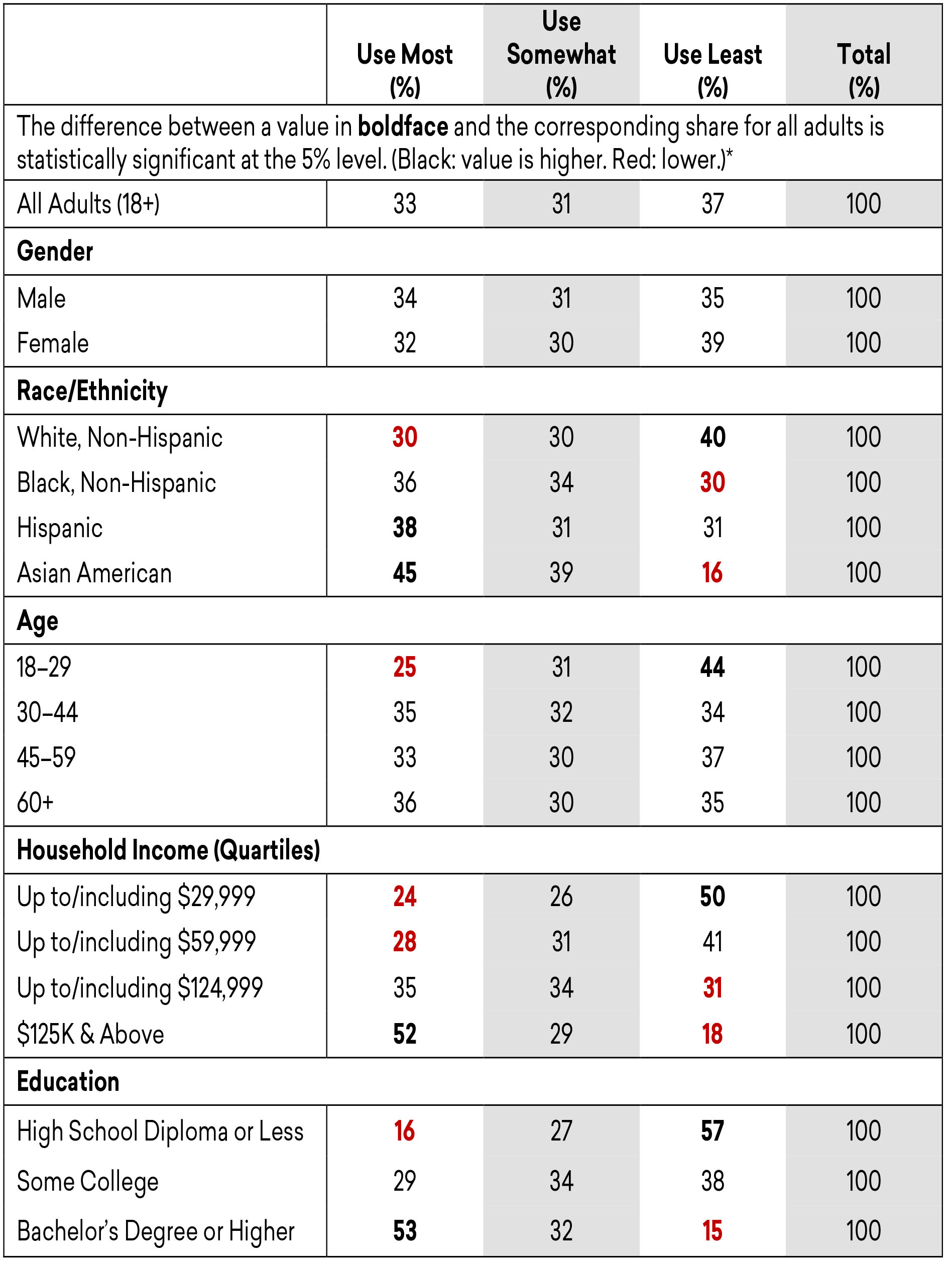
* Not every observed difference between demographic groups (e.g., between the youngest adults and those age 60+, or between Asian and White Americans) is statistically significant at the 5% level. The report narrative discusses notable differences that were found to be statistically significant. The “most”/“somewhat”/“least” shares for a given demographic group may sum to 99% or 101% due to rounding.
Source: Survey of the Humanities in American Life, 2019.
For instance, White Americans were somewhat less likely than Black and Hispanic Americans, and substantially less likely than Asian Americans, to report using these skills at work. The survey also found an association between age and the use of humanities skills, with the youngest adults, ages 18 to 29, less likely than older age cohorts to deploy these skills at work.
Americans in the highest income bracket were substantially more likely than less affluent Americans to employ these skills in the course of their work. The education gap was also pronounced, as 53% of Americans with a college education were among those most likely to use humanities skills at work (compared to just 16% of Americans with a high school education or less). As with overall engagement with the humanities in people’s personal lives (described in Chapter 1), no gender difference was detected in the use of humanities skills at work.
The age, income, and education disparities described above also extended to most of the humanities skills when examined individually (with a focus on the share using a skill often or very often; Figures 4D & 4E). Some of the widest differences were found in relation to reading and writing, where a gap of more than 26 percentage points separated the highest and lowest income quartiles on every skill. The disparity was even larger—more than 32 percentage points for each skill—between those with college degrees and those with a high school education or less.
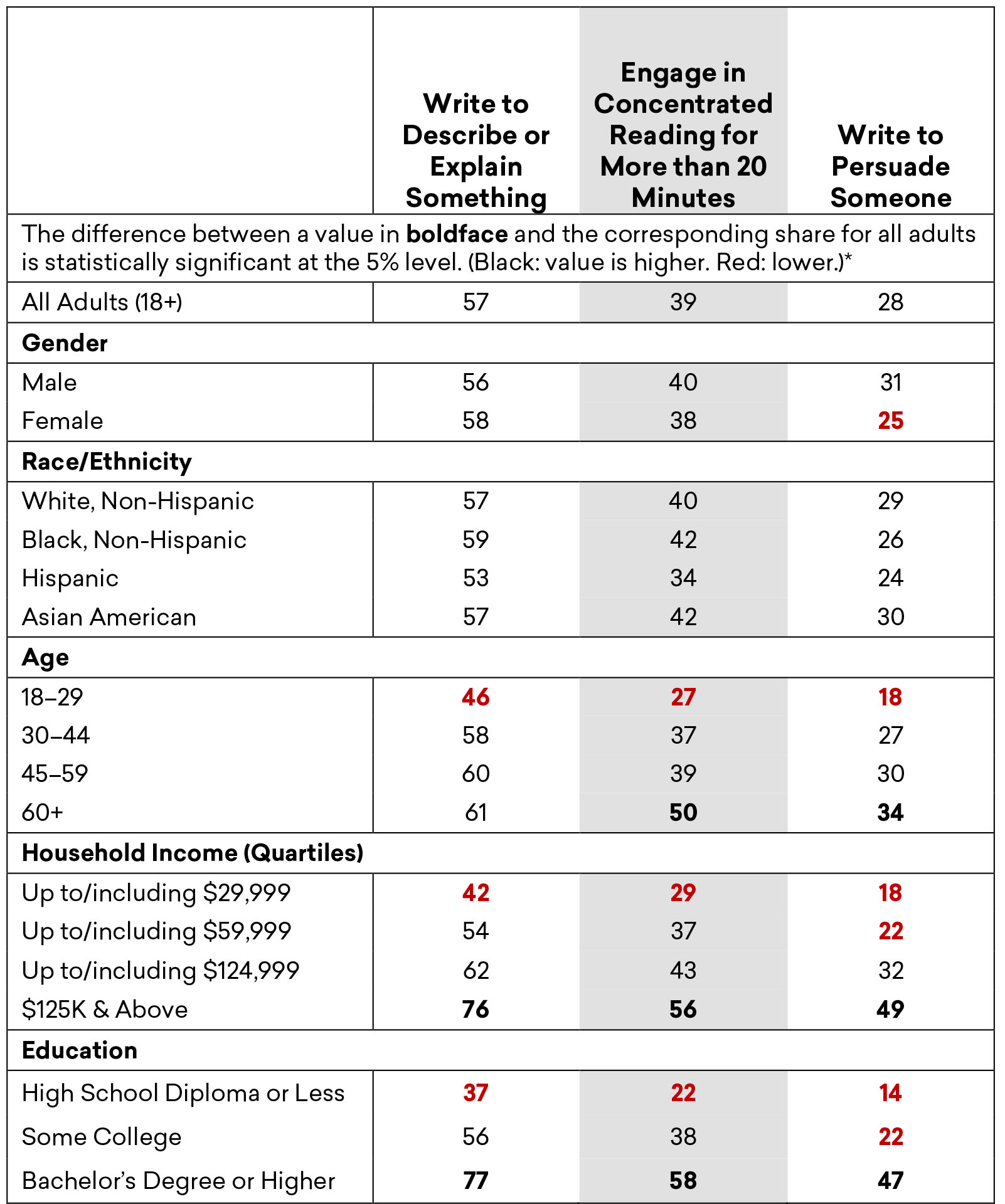
* Not every observed difference between demographic groups (e.g., between the youngest adults and those age 60+, or between Asian and White Americans) is statistically significant at the 5% level. The report narrative discusses notable differences that were found to be statistically significant.
Source: Survey of the Humanities in American Life, 2019.
Though the disparity was less pronounced, the association with education was found for all the other skills about which the survey inquired except LOTE. Use of LOTE was a standout in two other respects. First, the direction of the correlation with income was reversed, with less affluent Americans being more likely than those with more income to have used that skill on the job often or very often. Second, the correlation with age was reversed, with younger people being more likely to have deployed languages other than English in the workplace.
Only one statistically significant difference was found by race/ethnicity in the use of reading and writing skills at work: Hispanic Americans were somewhat less likely than Black Americans to have engaged in concentrated reading often or very often. But when it came to the three skills that involved negotiating diversity (in the forms of culture, viewpoint, or language), Whites were substantially less likely than other racial/ethnic groups to have frequently used these abilities at work. For example, just 3% of Whites often used a language other than English at work, compared to 30% of Hispanics and 18% of Asian Americans. Additionally, while almost 60% of Asian Americans had often balanced opposing viewpoints, only a third of Whites had done so.
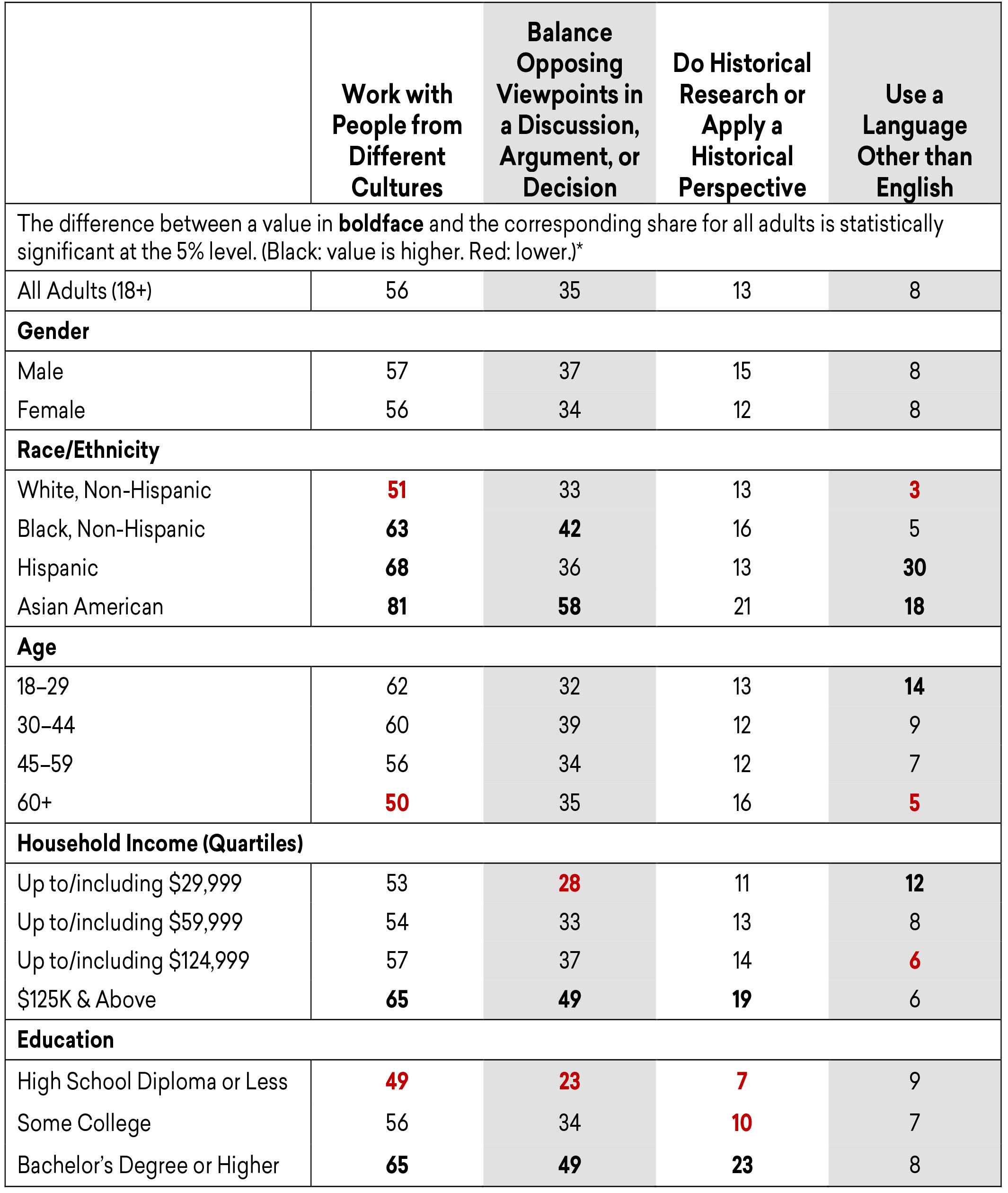
* Not every observed difference between demographic groups (e.g., between the youngest adults and those age 60+, or between Asian and White Americans) is statistically significant at the 5% level. The report narrative discusses notable differences that were found to be statistically significant.
Source: Survey of the Humanities in American Life, 2019.
While highly educated Americans were more likely to use humanities skills on the job, the analysis did not detect statistically significant differences among the various college majors with respect to the likelihood of frequently using these skills at work.
Humanities: Not Required for (Some) Jobs
As shown in Figure 4B, a sizable share of Americans—from approximately one-fifth to almost one-half—believed that they did not require each of the humanities-related skills included in the survey to do their jobs. Further analysis revealed that among the demographic variables included in the study, two—income and education, the same factors that were so closely associated with the use of humanities skills on the job—were most predictive of whether Americans felt these skills were required for their job. As Figures 4F and 4G illustrate, Americans with lower incomes and lower levels of education were more likely to think that most humanities skills (the exception being use of LOTE) were unnecessary for their jobs. For example, 33% of Americans in the lowest income quartile thought descriptive writing was not necessary, and 28% of them believed they did not need to read technical materials related to the job (Figure 4F). Less than half as many Americans in the top two income brackets thought the same.
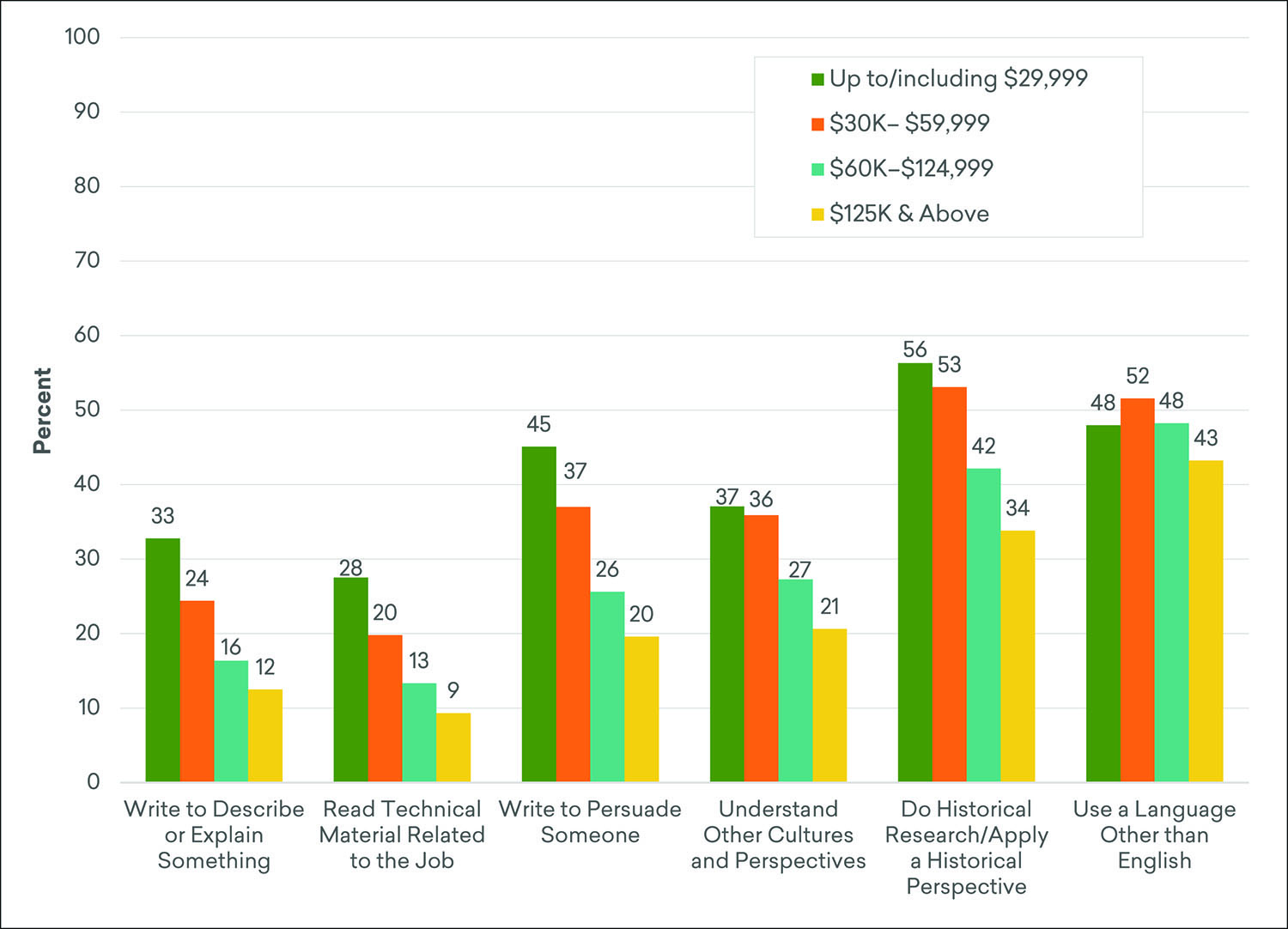
* Not every between-group difference depicted in the graph is statistically significant at the 5% level. The report narrative describes notable differences that were found to be statistically significant at that level.
Source: Survey of the Humanities in American Life, 2019.
Americans without a college education were also substantially less likely to report a need for humanities skills in their jobs than Americans with college degrees (Figure 4G). For instance, while more than 30% of Americans with only a high school education or less thought reading technical material or writing to describe or explain something was unnecessary for their jobs, just 8% of Americans with a college degree shared those views.
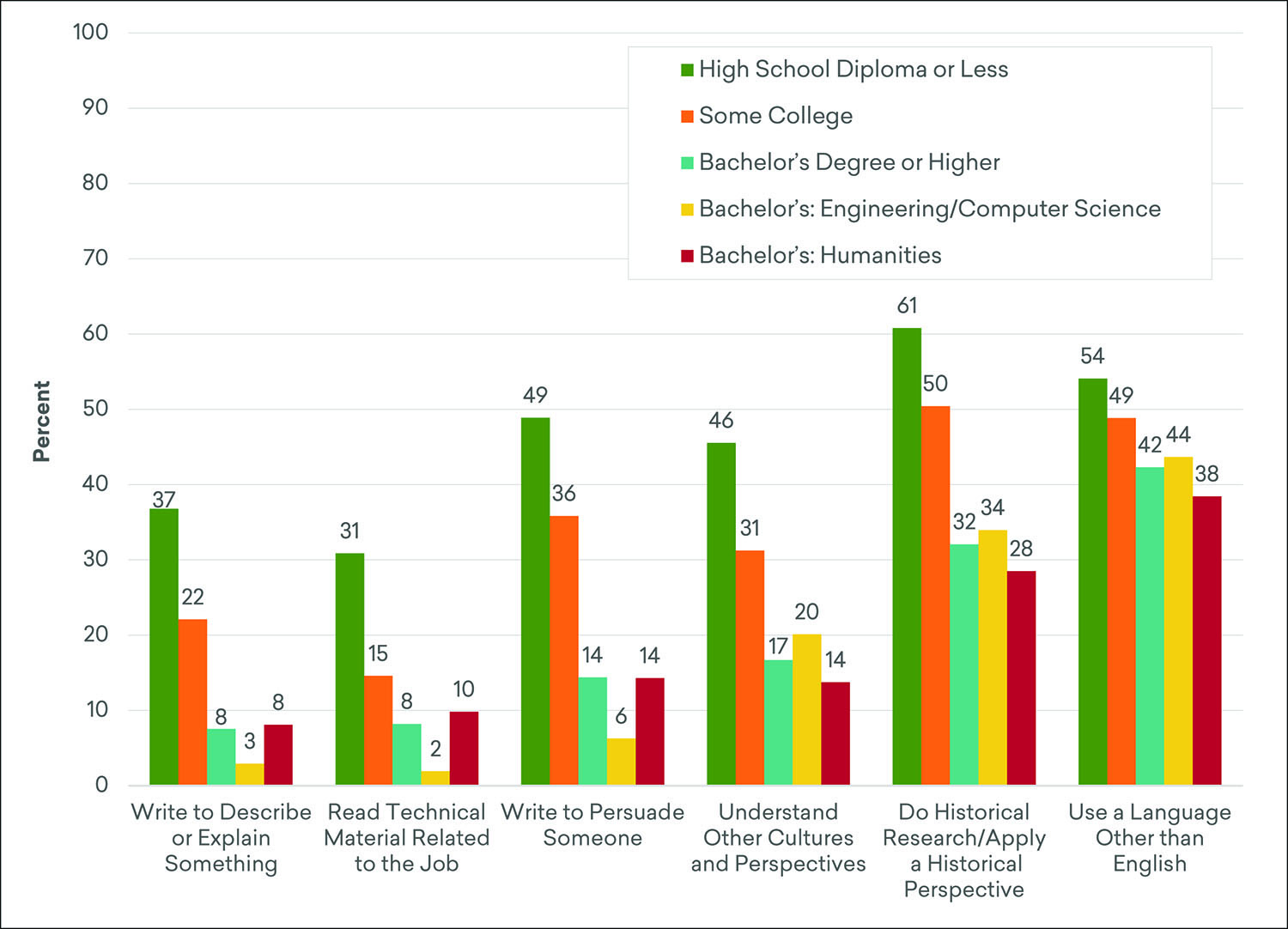
* Not every between-group difference depicted in the graph is statistically significant at the 5% level. The report narrative describes notable differences that were found to be statistically significant at that level.
Source: Survey of the Humanities in American Life, 2019.
The narrowest gap between college graduates and those with a high school education or less was found in the shares who did not consider a language other than English necessary for their work. Fifty-four percent of Americans with no more than a high school education thought language use unnecessary, and 42% of Americans with a bachelor’s degree or higher concurred.
An analysis of college graduates by major revealed that for three skill areas—both types of writing as well as technical reading—Americans with a bachelor’s degree in engineering/computer science were less likely than both college graduates in general and humanities majors to believe the skills were unnecessary for their job. For example, only 6% of engineering/computer science majors thought persuasive writing unnecessary for their jobs, compared to 14% of both humanities majors and the college-educated population as a whole.
Humanities Deficiency as a Career Limitation
The survey was designed to gauge the extent to which Americans believed that the inability to deploy a humanities-related skill had limited them professionally. However, because the survey asked whether respondents felt hampered in their ability to advance “at your job,” the responses do not reveal how lack of a particular skill might have shaped someone’s larger career (e.g., by preventing them from applying for a job or being hired). Further research will be required to fully understand the role of humanities skills in Americans’ career trajectories.27
What the survey does reveal is who was most likely to feel that a deficiency in a humanities skill had hampered their ability to perform or advance in their job. The shares in Figures 4H and 4I are of those Americans who believed that a given skill was necessary for the performance of their job. As Figure 4B indicates, the share of Americans who believed that a skill was not necessary for their job ranged from 18% for “read technical material related to the job” to 48% for “use a language other than English” and “do historical research or apply a historical perspective.” The shares shown in Figures 4H and 4I were thus calculated using a markedly smaller denominator, which is why the shares for all adults in the first row of those two tables are greater than the shares obtained by summing the “very limited,” “somewhat limited,” and “only a little limited” segments of each column in Figure 4B.
Of those who believed that reading and writing were necessary for their job, approximately one-third felt they had been limited at least a little bit in their career advancement by an inability to perform these skills (Figure 4H). Non-White Americans, the youngest adults, and those with less income were more likely to indicate that the lack of one of these skills had been an impediment in their work life.
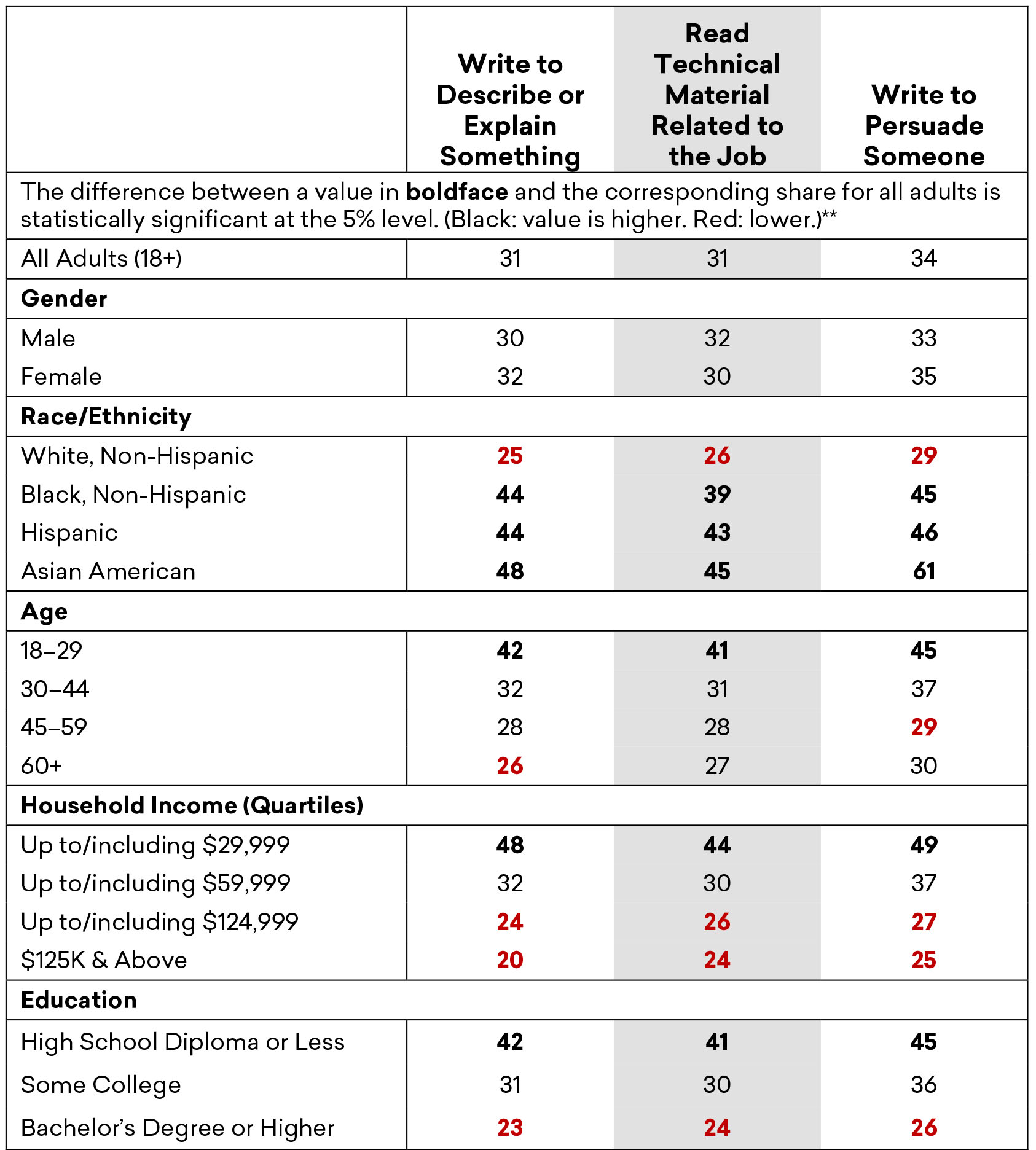
* Share indicating that the skill is necessary for their job.
** Not every observed difference between demographic groups (e.g., between the youngest adults and those age 60+, or between Asian and White Americans) is statistically significant at the 5% level. The report narrative discusses notable differences that were found to be statistically significant.
Source: Survey of the Humanities in American Life, 2019.
Americans with less education were also substantially more likely to indicate that they were limited by a deficiency in one of these skills. More than 40% of Americans with a high school diploma or less felt that their limited skills in this area held them back in their jobs. While it was markedly smaller, a substantial share of Americans with college degrees also felt limited by their reading and writing skills (23–26% percent). No statistically significant differences were found among the college majors with respect to the share who felt hampered by a deficiency in these skills.
For the three other humanities skills—understanding other cultures and perspectives, doing historical research or applying a historical perspective, and using LOTE—those with less income and education were again likelier to report difficulty (Figure 4I). The youngest adults were substantially likelier than older Americans, and women modestly more likely than men, to indicate that a lack of proficiency in applying a historical perspective or using LOTE was a barrier to their advancement.
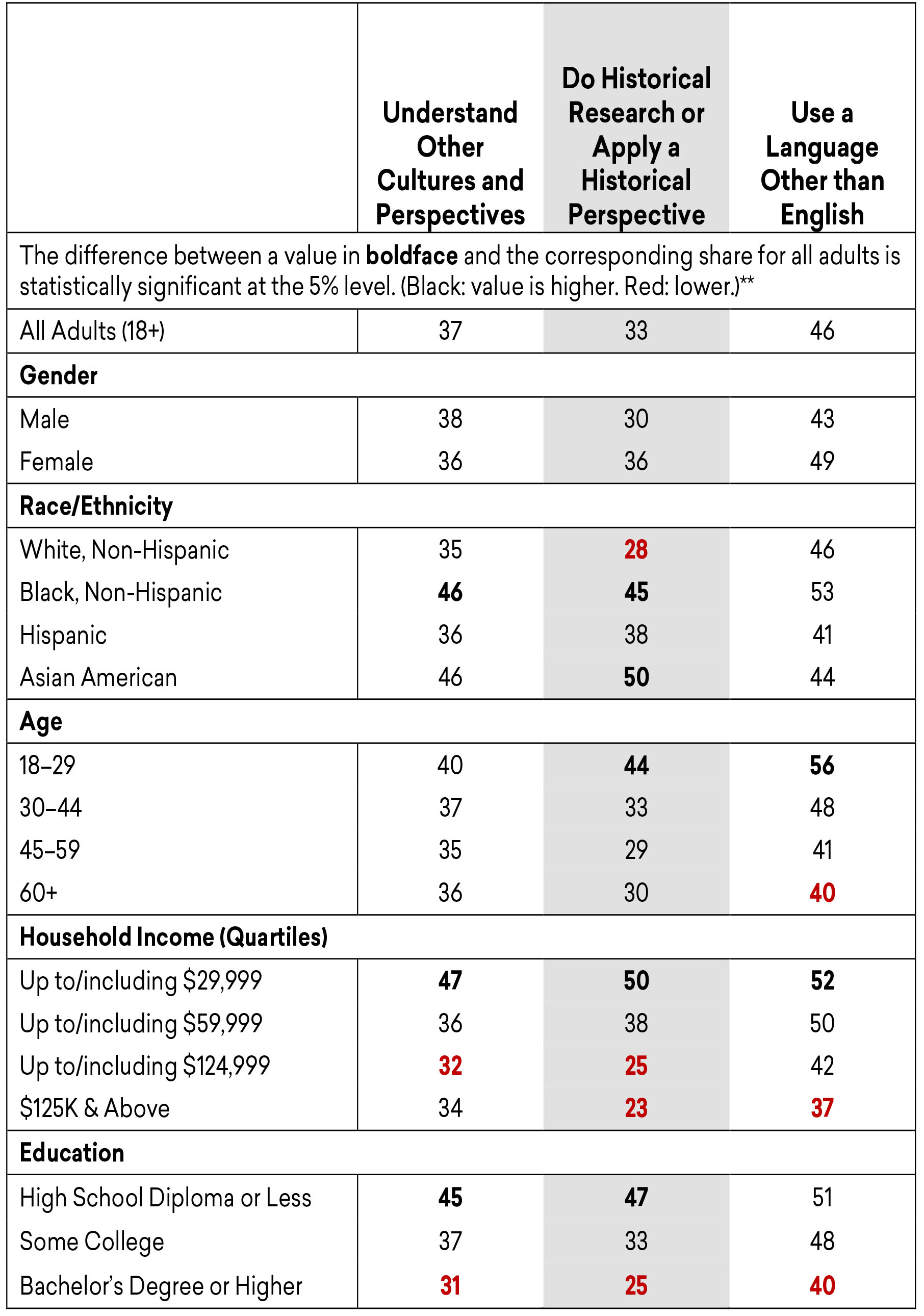
* Share indicating that the skill is necessary for their job.
** Not every observed difference between demographic groups (e.g., between the youngest adults and those age 60+, or between Asian and White Americans) is statistically significant at the 5% level. The report narrative discusses notable differences that were found to be statistically significant.
Source: Survey of the Humanities in American Life, 2019.
Black, Asian, and Hispanic Americans were more likely than Whites to report having been held back professionally due to a skill deficit in employing a historic perspective at work. And Black Americans were more likely than Whites and Hispanics to feel that they suffered professionally from an inability to understand other cultures and perspectives. Finally, the study detected another difference between Black and Hispanics, with the former more likely to report that a lack of multilingualism was a barrier to advancement.
Workplace Use: Relationship with Leisure-Time Engagement and Perception
This analysis did not attempt to establish a causal linkage between use of the humanities in the workplace and either attitudes about the field or engagement in humanities activities outside of work. Nevertheless, the survey did find a correlation between using humanities skills at work and both perception and leisure-time engagement.
Americans who used the humanities most at work were more likely to have highly positive views of the humanities (using the scale described in Chapter 2; Figure 4J). While 48% of Americans who used the humanities most often at work were “fans” of the field, only 26% of Americans who used the humanities least often in their job were as enthusiastic.
The relationship between work use and enthusiasm was somewhat less pronounced when examined in light of Americans’ reaction to some of the specific statements linking the humanities and the economy. The strongest association was found for the statement, “the humanities help Americans work more effectively and creatively.” Almost half of Americans who used humanities skills the most in the workplace strongly agreed with that sentiment. While that share was larger than for those who used humanities the least at work (32%), when those who somewhat agreed with the statement are considered along with those who strongly agreed, the difference between the two workplace-use segments is negligible.
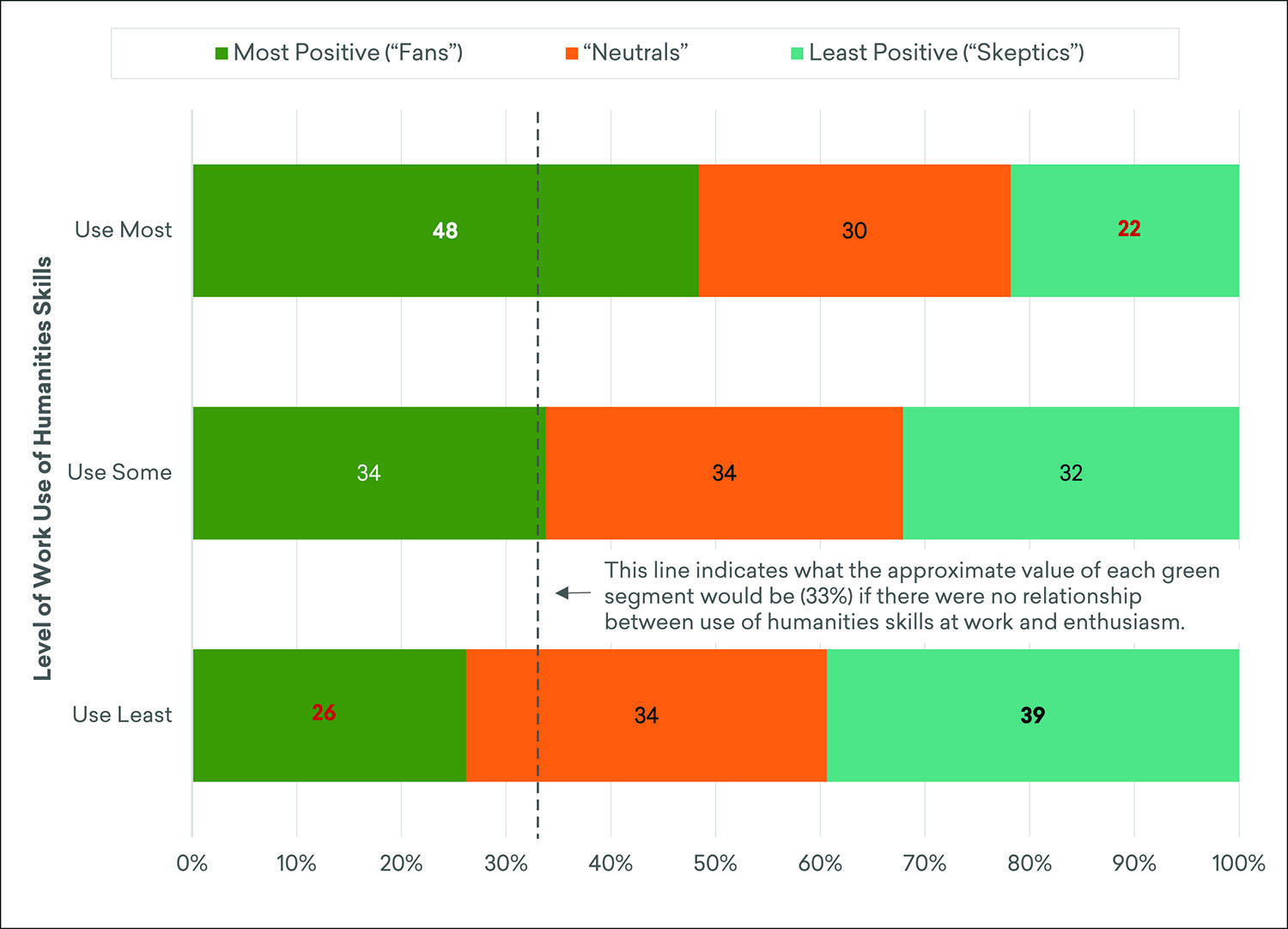
* Values in boldface are measurably different (black/white: higher; red: lower) at the 5% level from the share for all adults. Not all differences between use segments depicted in the graph are statistically significant at the 5% level. The report narrative describes notable differences that were found to be statistically significant. The “fans”/“neutrals”/“skeptics” shares for a given work-use level may sum to 99% or 101% due to rounding.
Source: Survey of the Humanities in American Life, 2019.
For the proposition that the humanities “help children and adolescents develop the skills they need in life,” 54% percent of Americans who used humanities skills the most at work strongly agreed, compared to only 37% of Americans who used such skills the least at work. Americans who used the humanities most often at work were also more likely than lower intensity work users to agree that the humanities help “make the economy stronger,” but just 33% of the heaviest users of humanities skills at work strongly agreed with the statement.
A stronger relationship was found between work use and engagement with the field in one’s leisure time (Figure 4K). Fifty-six percent of the Americans who used the humanities most at work were also among the “most engaged” with the humanities in their personal lives. Only 17% of the those who used the humanities least at work were as engaged outside the job.
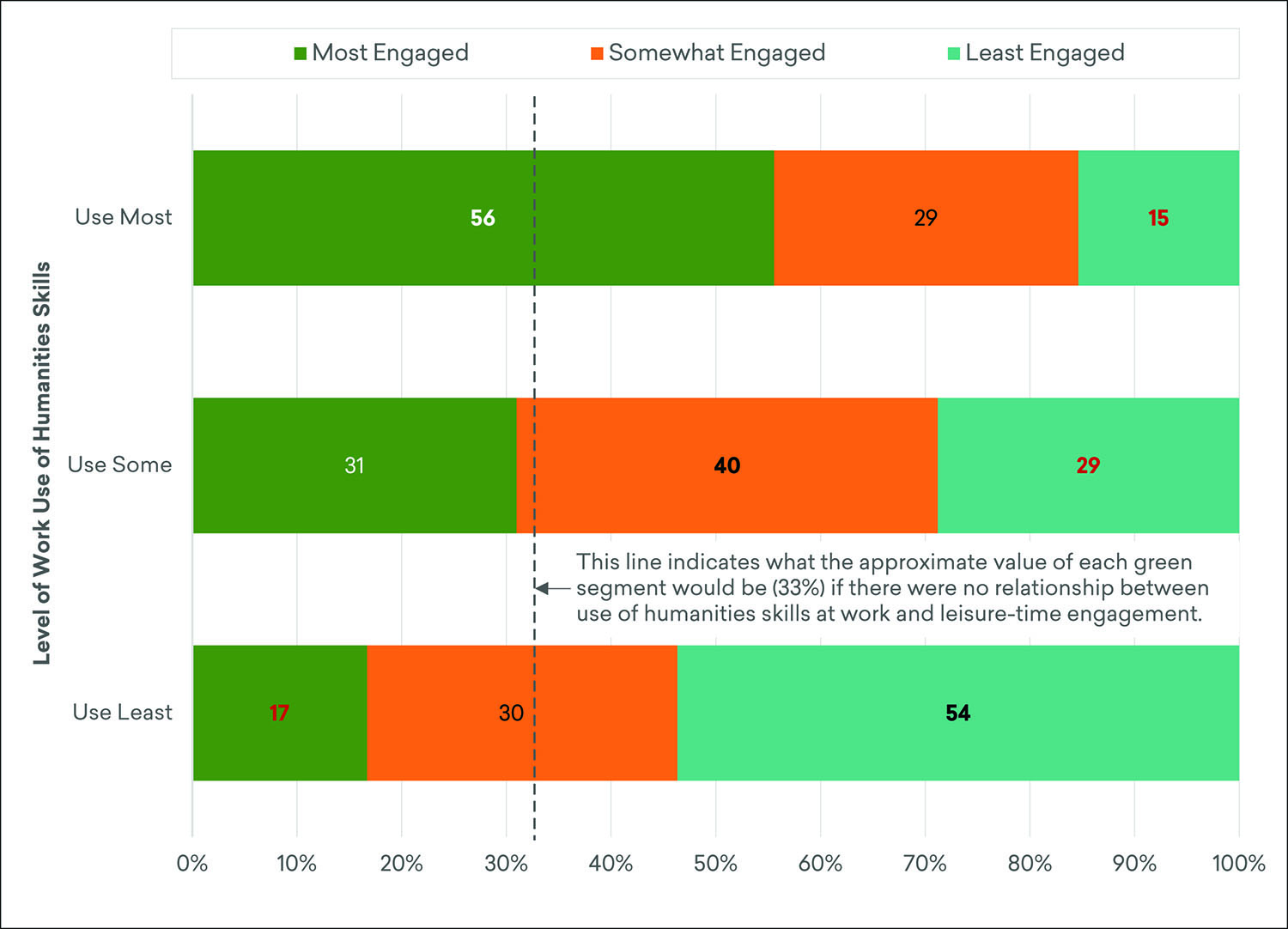
* Values in boldface are measurably different (black/white: higher; red: lower) at the 5% level from the share for all adults. Not all differences between use segments depicted in the graph are statistically significant at the 5% level. The report narrative describes notable differences that were found to be statistically significant. The “most”/“somewhat”/“least” shares for a given work-use level may sum to 99% or 101% due to rounding.
Source: Survey of the Humanities in American Life, 2019.
The correlation between work use and leisure-time engagement was most apparent in the case of speaking LOTE. Seventy-seven percent of Americans who often or very often used another language in the workplace also often or very often used a LOTE with family and friends. Only 6% of those who rarely used a LOTE at work used such a language often or very often at home.
Though the association was still substantial, work use was less predictive of leisure-time reading and historical research. Thirty-eight percent of Americans who did concentrated reading often or very often at work read nonfiction as often outside of work, while 16% of those who rarely or never did concentrated reading at work often read nonfiction outside of work. As further evidence of the more tenuous relationship between work and leisure-time reading, almost 30% of those who often did concentrated reading at work rarely or never read nonfiction at home. Fifty-seven percent of Americans who often or very often included a historical element in their work also frequently sought information on history subjects in their home lives. Only 28% of those who rarely did historical research or applied a history perspective at work researched history topics outside of work with any frequency.
In statistics, one is routinely reminded that correlation is not causation, and that is a particularly important reminder here. These findings can point only to an association between Americans’ use of humanities skills at work and their level of enthusiasm for and engagement with the humanities as a field. Whether use of the humanities at work fosters (or is fostered by) attitudes toward the field and leisure-time engagement remains an open question.
The causality question is not the only one raised by these findings. What should one make of the substantial share of Americans who engaged in an activity at work but not outside it? And why did such a large share of those who used the humanities intensively at work not embrace the idea that the humanities contribute to a healthy economy? Once again, this survey can point only to interesting areas for further research.